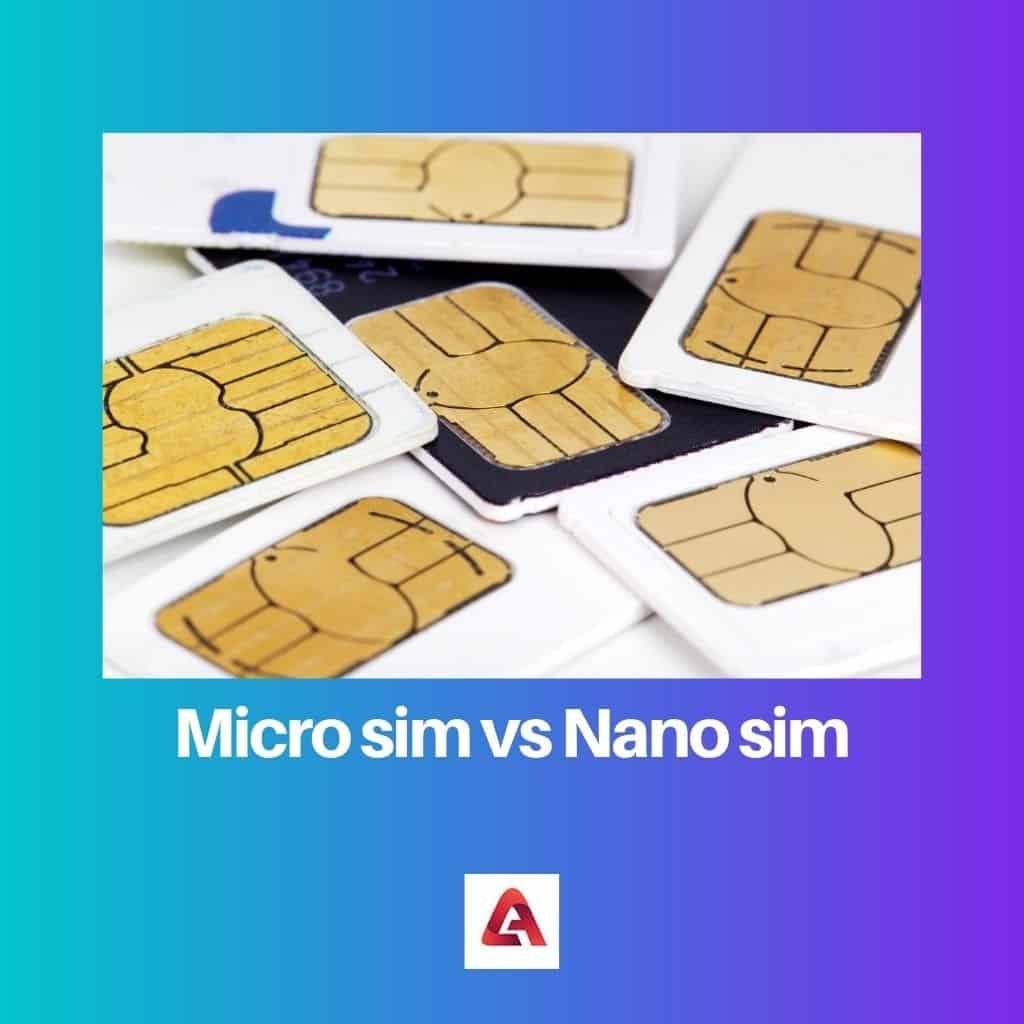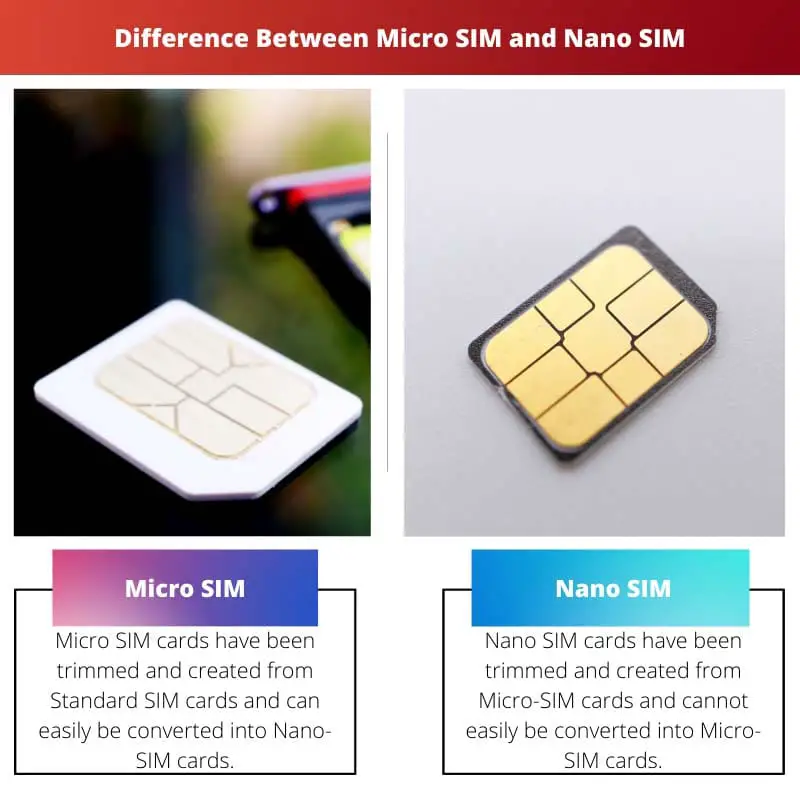For a mobile phone to gain access to prevailing possibilities like messaging or calling another cell phone user, it wouldn’t have been possible without the chief component of the phone, the SIM card. It is true that all phones, big or small, require SIM cards.
However, these phones don’t always require SIM cards to be of uniform size.
The primary model of these SIM cards was recognized as the Standard SIM card, and the following models were then called Mini cards, which were comparatively more compact. The successor of these Mini-cards was then recognized as Micro-cards, while the present-day model is widely known as the Nano cards.
However, the difference between these cards is not just confined to their size. In this article, we will compare the two cards- Micro SIM cards and Nano-SIM cards and clarify the certain dissimilarities between them.
Key Takeaways
- Micro SIM cards are larger, measuring 15mm x 12mm; Nano SIM cards are smaller, measuring 12.3mm x 8.8mm
- Micro SIM cards were introduced in 2010; Nano SIM cards were introduced in 2012
- Both Micro and Nano SIM cards perform the same functions, but their size differences accommodate evolving device designs
Micro SIM vs. Nano SIM
The difference between Micro-SIM and Nano-SIM cards is that Micro cards are third-generation cellular chips which are not only the more extensive version when compared to the Nano-SIM but are also the more compact version of the Mini-SIM cards as a result of removing the additional plastic around the SIM card circuit. In contrast, Nano cards are fourth-generation SIM cards, which are comparatively smaller than a Micro-SIM to keep the gold portion and have merely enough area of insulation around it to avert short circuits.

Comparison Table
| Parameter of comparison | Micro SIM | Nano-SIM |
|---|---|---|
| Form Factor | Micro SIM cards are considered the third form factor (3FF). | Nano SIM cards are considered the fourth form factor (4FF). |
| Interconversions | Micro SIM cards have been trimmed and created from Standard SIM cards and can easily be converted into Nano-SIM cards. | Nano SIM cards have been trimmed and created from Micro-SIM cards and cannot easily be converted into Micro-SIM cards. |
| Shape | Micro SIM cards are more significant as they have 15 × 12 × 0.76 mm specifications. | Nano SIM cards are smaller and have 12.3 × 8.8 × 0.67 mm specifications. |
| Chain | Micro SIM cards have given rise to the creation of Nanochips. | Nano SIM cards have given rise to the creation of embedded chips. |
| Tools | Since Micro-SIM cards can easily be converted into Nano SIM cards, they do not require any tools to transfer the necessary data. | Since Nano-SIM cards cannot easily be converted into Micro SIM cards, an adapter is required to transfer all the data from the Micro to the Nano-SIM cards. |
What is Micro SIM?
Micro SIM cards are smaller than standard SIM cards and are considered third-generation. Micro SIM cards have been reduced from Mini-SIM cards by trimming them at the edges around the circuit.
Micro SIM cards were introduced in the market in 2003 but aren’t much in use now due to the cutting-edge technology and the introduction of Nano-SIM cards.
Micro SIM cards were initially used in iPhone 4’s in 2010, even though they were developed in 2003. The chips of the Micro SIM cards are the same size, but the edges are smaller and thinner than standard SIM cards.
The length of the Micro SIM cards has been reduced from 25mm to 15mm, and the width has been reduced from 15mm to 12mm. However, although the length and width of the Micro SIM cards have declined, the thickness of 0.76 remains the same as it has solely considered the fact of saving more space.
Some Micro SIM cards are attached to the standard SIM cards, which one can easily pull off. This is known as Combi SIM, as both the standard and the Micro SIM cards can be used.

What is Nano SIM?
Nano SIM cards are the most miniature SIM cards specifically suited for new-generation smartphones or the latest wifi-cellular devices. They were introduced in the market in 2012, and the replacement of Nano-SIM cards with Micro-SIM cards took place very swiftly due to technological advancement.
Nano-SIM cards have been trimmed down from Micro-SIM cards to save up space in smartphones as this ends up creating small SIM slots in phones to provide the benefit of having two Nano-SIM cards in the place of one. Micro SIM cards and Nano-SIM cards have the same design, but Nano-SIM cards are smaller and thinner when compared to Micro SIM cards.
Nano-SIM cards are also widely used in almost all phones nowadays. Nano SIM cards measure 12.3mm in stature, reduced from 15mm, 0.67mm in thickness, 0.76, and 8.8mm in width, reduced from 12mm.
Nano-SIM cards have two sections in the storage system, i.e., one for system information and the subsequent for user information. The introduction of Nano-SIM cards also brought about specific difficulties people faced when it came to transforming their Micro SIM cards into Nano-SIM cards.

Main Differences Between Micro SIM and Nano SIM
- Micro-SIM cards have a third form factor since they have a length and width of 15mm and 12 mm. Nano-SIM cards have a fourth form factor since they have a size of 12.33mm, width of 8.8mm, and thickness of 0.67mm.
- Micro SIM cards can easily be trimmed from Standard SIM cards and easily convertible to Nano SIM cards. Nano-SIM cards can be easily shortened from Micro-SIM cards as this creates a lot of space in the latest smartphones, and Nano-SIM cards cannot be convertible into Micro-SIM cards.
- Micro SIM cards are more significant in size when compared to Nano SIM cards since there were introduced in 2003 and have a height, width, and thickness of 15 × 12 × 0.76 mm. Nano SIM cards are concise in size when compared to Micro SIM cards since they were developed in the advanced technology era of 2012 and had a height, width, and thickness of 12.3 × 8.8 × 0.67 mm.
- Micro SIM cards have created smaller nanochips for creating more space in one’s electronic device. Nano SIM cards have made concise embedded chips to help mobile phones create efficient control.
- For a Micro SIM card, no tool is required to convert a Micro SIM into a Nano SIM. For a Nano SIM card, a specific tool called an adapter is required to transfer data from the Micro SIM to the Nano SIM on conversion.

- https://tarjomefa.com/wp-content/uploads/2017/10/TarjomeFa-F210-English.pdf
- https://ieeexplore.ieee.org/abstract/document/8554774/